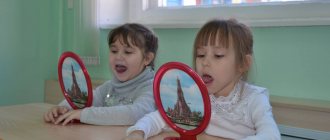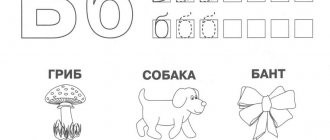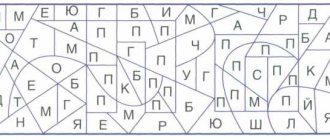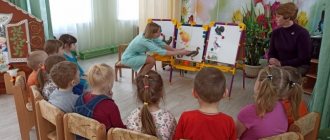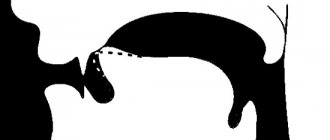What prevents you from pronouncing the letter “r” correctly?
The main reasons why this sound is not pronounced are problems associated with the oral cavity.
Short hypoglossal ligament
Another name is bridle. It is this that prevents the tongue from moving freely. Usually this defect is corrected in the maternity hospital. It can also interfere with your baby's ability to latch onto the nipple properly during breastfeeding. If this defect was discovered at school age, it is stretched with speech therapy exercises.
Problems with phonemic awareness
Phonetic hearing is the ability to hear and perceive sounds correctly. At three years old, children should be able to distinguish sounds that are similar to each other, although they cannot yet pronounce them. In some cases, such disorders are associated with adenoids and other diseases. Thus, the child does not hear a certain sound and in his speech he replaces it with another similar one.
Incorrect speech breathing
To correctly pronounce sounds, including the letter P, you need to control your exhalation. Not all children can do this at an early age. Some raise their shoulders to do this, others do not know how to regulate their breathing during speech.
Bite
A correct bite involves the upper teeth overlapping the lower ones by about a third, the remaining teeth should close tightly together. With an incorrect bite, it is physiologically impossible to produce some sounds correctly. The child's bite will need to be corrected.
How to teach a child to say the letter “r” independently
Using the exercises below, you can easily teach your child to pronounce “r”. They should be carried out several times daily in the form of games. It is recommended to sit in front of a mirror so that the child can see how his lips work. It is best to first show everything by example. Classes should be held in a friendly atmosphere, and if a child does not succeed, under no circumstances should you shout at him. This can only make the situation worse. Only patience and attempts one after another, this is the only way to help a child hone the pronunciation of the letter “r”.
How can a child distort "R"
Incorrect “r” sounds are called rhotacism - these are the sounds that are replaced instead of this letter. Before determining exercises for producing the sound R, it is necessary to understand exactly how the child pronounces this sound. It happens like this:
- Burr or speaking through the throat. When pronounced, the palate vibrates instead of the tip of the tongue. A similar phenomenon is more typical for French, but not for Russian.
- Lateral "R". This happens if the side is pressed against the upper jaw, the opposite side hangs down. In this case, the tip cannot vibrate, and the sound P itself is more similar to “rl”.
- Single-stroke "r". Instead of shaking, the tip hits the roof of your mouth. This is how the English letter “R” is pronounced.
- Pronunciation through the nose. The air flow must pass through the mouth.
- Kucherskoe R. The tongue vibrates on the pressed lips, resulting in the sound “tpr”, not a pure R.
- Pararotacism. This is the phenomenon of replacing the sound P with another, for example G.L,V.
- Pass. The child simply does not pronounce this sound at all and misses it in his speech.
How to correct a child’s throat “r” and whether it should be done
Often, when children begin to speak, at some point they use the guttural “r” instead of the normal one. Parents do not pay attention to this, expecting that later everything will get better on its own. All other sounds soon sound correct. But the throaty “r” is in no hurry to leave. And only at school do parents come to their senses and take the child to a speech therapist. And he exclaims: “Where have you been before?”
But many parents do not try to correct the throaty “r” to a normal one. They think it’s even piquant and sounds French. Only the French pronounce their “r” completely differently. And if you are planning to teach your child French (which, of course, is wonderful!), then no one has canceled their native Russian.
Parents' admiration disappears when classmates begin to tease the child, calling him “bad,” or when the teacher makes it clear that something needs to be done about the problem. So is it still necessary or not?
What exercises can you do at home?
Exercises should be aimed at the reason why the child cannot pronounce this sound R.
Exercises for the hyoid ligament
This exercise improves the elasticity of the tongue muscle and develops its mobility. The exercise consists of the following:
- try to reach your nose with the tip;
- the tongue is pressed firmly to the palate and drawn towards the throat as far as possible;
- open your mouth, bend your tongue out as far as possible;
- carried out along the inside of the teeth in different directions;
- rolls up with a shovel and sticks out.
Exercises to develop mobility of the tip of the tongue
The sound P appears only when the tip vibrates. To develop this, there are special exercises:
- bite the tip;
- click the tongue pressed to the palate;
- the protruding tongue is pressed against the lip and air is exhaled, thereby creating vibration at its tip;
- pronounce the letters D, T with your mouth open.
- "D" and "T".
Statement P
Exercises aimed at correct pronunciation:
- R is pronounced in the position of the tongue in which the sounds D and T are pronounced, but with slight vibration. To do this, the tongue is pressed tightly against the palate and the air is exhaled.
- Say "DRRRRR" or "TRRRRR".
- Connecting to the sound of vowels, for example DRO, BRO, VRE.
- Pronounce words with a combination of the letters “tr” and “dr”.
- Consolidating the result with tongue twisters.
It is advisable to do all these exercises in front of a mirror and under the supervision of an adult, who should help and advise.
Throat pronunciation of R, causes of occurrence
I would like to focus your attention on the causes of this speech defect. Why, being surrounded by a social environment where non-throat sounds are normative, did the child choose this particular method of pronunciation? So something contributed? What could it be?
- A short hyoid frenulum, which limits the mobility of the tongue and affects the bite.
- Chronically enlarged tonsils, which keep the area of the root of the tongue in an excited state, and it is easier for the child to make a bow with the back of the palate and the root of the tongue than with the front of the tongue with the anterior third of the palate.
- Hypotonicity or hypertonicity of the tongue, which, by the way, often reflects the situation in the body (you don’t know why your child is awkward, falls out of the blue, everything falls out of his hands, and it seems to you that this is absent-mindedness, but here you need the help of a massage therapist or osteopath).
- Impaired phonemic hearing, which should not be confused with physical hearing, and which will seriously affect the quality of education in the future. For example, a child writes instead of U-O, instead of B-P, does not add endings and/or misses letters in the middle of a word.
- A variant of organic damage, which, in addition to the sound R, will cause problems of a neurological nature: fears, fatigue, unreasonable mood swings, sensitivity to stuffiness and motion sickness in transport.
It is better to entrust an accurate diagnosis of the problem that led to the appearance of throaty pronunciation in a child to professionals. And you need to start with a consultation with a speech therapist. If necessary, he will refer you to other specialists, for example, a pediatric ENT specialist or a pediatric dentist. All the necessary specialists work at the Dial-Dent clinic.
Articulation exercises
Before starting all the exercises, you need to do gymnastics, and only then proceed to the training itself.
Swing
Loose tongue with open mouth. You need to touch the upper and lower teeth. Periodically lingers on the top for 10-20 seconds.
Cuckoo
The tip sticks out and touches the upper lip, and then goes behind the upper teeth. The mouth should be wide open.
Painter
The tongue is passed over the teeth, cheeks, and palate. The tongue is like a brush and you need to paint the inside of the oral cavity with it.
horse
The tongue makes clicking sounds.
Treat
The tongue licks the lips clockwise.
Kitty
Lick an imaginary treat from a saucer. The tongue should not be curled.
Harmonic
You need to raise your tongue and secure it to the roof of your mouth. In this position, close your mouth.
Hammer
Smile widely and tap your lower teeth with the tip of your tongue.
Preparation of the articulatory apparatus
In correctional classes, the preparatory stage is devoted to working with the articulatory apparatus. Exercises are performed to stretch the hyoid ligament, lift the tongue upward, and warm up the lips and jaw.
Tasks for preparing the articulatory apparatus for work:
- “Swing” - open your mouth, stretch your tongue alternately to your nose and chin.
- “Horse” - click your tongue slowly and forcefully, imitating the sound of a horse’s hooves, while the lower jaw remains motionless.
- “Chatter” - use the wide tip of your tongue to run back and forth along your upper lip, without lifting your tongue. Simultaneously say “BL-BL-BL”.
How to make the sound R
It is recommended to start with setting other sounds, and only after that move on to the letter R.
Drum
Hit your upper teeth with your tongue and at the same time pronounce the letter D. The pace gradually accelerates.
Buzzer
When pronouncing Zh, we slowly pull the tongue towards the throat. The sound Zh should go into R.
Snake
We repeat the letter C and swallow our tongue, touching the tip of the palate with it.
Turkey
You need to stick out your tongue and move it back and forth, making sliding movements with its tip along the roof of your mouth.
Komarik
You need to open your mouth, raise your tongue up and rest it on the alveoli, making buzzing sounds.
Motor
A finger is placed under the tongue and active movements are made. At the same time, the KOMARIK exercise is performed.
How to consolidate the result
If the child begins to pronounce this sound, it is necessary to reinforce this. To do this, there are some exercises:
- say R loudly several times;
- consolidate through the pronunciation of words and syllables with the letter P;
- remove exercises with “D”;
- switch to reverse pronunciations, instead of RA-RO, say AR-OR;
- use tongue twisters.
These exercises will consolidate the result and bring the pronunciation of the letter P to automaticity. At the initial stages, the amount of P should be large. The child must remember and get used to the articulation of this sound. P should be firmly fixed in his speech. An adult should pronounce it together with the baby, showing the correct pronunciation. Then the child must actively use words with R in his speech.
Sound production methods
Imitation
In children under six years of age, the sound P often appears as a result of their imitation. That is why adults must speak correctly, clearly, as clearly as possible. Adults must demonstrate perfect phonetic pronunciation.
Exercises from "F"
If the pronunciation of this letter is not impaired, then when pronouncing it, the tongue is moved with a finger or a stick inside the mouth. So the letter Zh smoothly turns into R. This is reinforced by frequent repetition, gradually the child pronounces the desired sound without using an auxiliary one.
If a preschooler pronounces “F” correctly, then when pronouncing it, you can move the tongue with a stick deeper into the mouth. A short “R” is formed. Strengthen it by repeating the exercises. After automating “R”, select words without using “F”.
Exercises from "C"
The child must draw out the letter, inhale and press his tongue against the alveoli. This is how R will appear. By carrying out strengthening exercises, you can achieve complete automation of R in speech.
Production from "Z"
When pronouncing “Z,” the child lightly touches the alveoli with the tip of his tongue and simultaneously blows on the tongue. This way the required “P” will be heard with vibration. This method is similar to the “C” method and is rarely used by speech therapists.
Pronunciation of R while inhaling
Speech is pronounced when inhaling, it should be short.
Mechanical method
The sound R can be produced mechanically. This will require special speech therapy tools. The child should open his mouth and raise his tongue to the palate. At this time, the speech therapist makes tapping movements with a hammer on the alveoli and vibrates the tongue with a spatula. The sound must first be fixed with the help of instruments, then the child gets used to it and can do without them.
The vibration occurs when a wad of thick paper and string is placed on the tip of the tongue. When it is removed from the surface, you need to blow strongly on the tongue. This must be used carefully without injuring the child.
Setting “R” according to Khvattsev
This technique was created by teacher Mikhail Efimovich Khvattsev in 1959. This method consists of several successive steps:
- Composing individual phrases containing similar words that differ by one letter - pitifully hot, thief-ox and others.
- Causing vibrations in the tongue mechanically. To do this, knock on the gums.
- Getting the sound "R" from "D".
- Bringing pronunciation to automaticity, we pronounce syllables and words with this letter.
This technique is actively used today, although it appeared during the USSR period.
Levina's method
Rosa Evgenievna Levina created her own method in 1965, which consisted of articulation exercises for setting the letter R. At the beginning of the lessons, the fricative R is achieved, which does not have a characteristic vibration.
- The second stage is training the sounds Zh, Sh. You need to move your lips apart, but without rounding them. In this case, you need to pull out the sound Zh and move the tip of your tongue to the top.
- At the first stage, the exercises are aimed at obtaining the fricative "P" without vibration after achieving correct articulation.
- To obtain P, D is used, which must be pronounced while exhaling. The mouth should be open and the tongue connected to the upper gums.
How to conduct a speech therapy warm-up
All classes with a speech therapist or at home should begin with a warm-up. It has a number of tasks:
- develops motor skills and articulation;
- improves lower diaphragmatic breathing;
- develops oral and nasal pronunciation of individual sounds;
- activates the muscles of the palate, tongue, and pharynx;
- the child's voice and ability to speak with expression are assessed;
- a sense of rhythm is developed;
- improves the musculature of the articulatory muscles.
Here you can use various tongue twisters, rhymes, and children's songs.
Correct R sound
Speech therapists recommend putting this sound last. This usually happens at 5-6 years of age. Until this age, incorrect P is considered normal. Many children begin to pronounce it on their own, without the efforts of a speech therapist or special exercises. There are cases when the help of a speech therapist may be needed earlier. This is necessary if P has already appeared, but in the wrong form. It can be replaced by L, V and others. Normally, P should be pronounced when:
- relaxed lips;
- the distance between the lower and upper jaw does not exceed 5mm;
- the tongue is raised to the gums of the upper teeth;
- the tongue should vibrate;
- the middle part of the lingual muscle is slightly arched;
- the back part is pressed against the palate;
- the sides are pressed to the top;
- the vocal cords undergo intense vibrations.
Only in this case can the pronunciation be considered normal and correct.
When correction is needed
The sound “R” is one of the most difficult sounds in a child’s speech development. It belongs to the category of sonorants, in which there are more vocal tones than noise.
Experts put “P” last, when all other sounds have already been correctly formed and consolidated. The production of “R” begins after 5.5-6 years. Until this time, a violation in his pronunciation is the age norm.
In some cases, it is worth contacting a speech therapist from the age of 4, when “R” appears in speech, but does not manifest itself correctly. In this variant, the child does not replace “R” with other sounds (“L”, “V”), but tries to pronounce “R”, but with disturbances in the articulatory apparatus.
Norm for pronunciation of “R”:
- lips are relaxed;
- distance between teeth 4-5 mm;
- the tip of the tongue rises to the upper gums;
- the tongue vibrates in the air stream;
- the middle part of the back of the tongue arches;
- the back of the tongue is directed back, pressed against the palate;
- the side edges are pressed upward;
- The vocal folds vibrate when speaking.
Violation of the pronunciation of hard “P” and soft “Pb” in defectology is called rhotacism or pararotacism. In Soviet times, these violations were called burrs.
The main types of rhotacism that require correction:
- Velar. The tip of the tongue is lowered down and does not participate in articulation. The tongue is tense and pushed back. There is little voice in pronunciation, a lot of air. The sound is guttural and loud.
- Uvular. The tongue vibrates in the air stream. The sound is soft, quiet, smooth.
- Nasal. The air is directed into the nose, there is no vibration.
- Bilabial. Only the lips, without the tongue, take part in articulation.
- Slotted. The tongue is directed upward and forms a gap with the soft palate. The sound changes to “Z” or “Zh”.
- Interdental. The tongue is between the teeth.
Stages of correction of violations:
- Preparatory.
- Sound production.
- Automation.
- Differentiation.
- Consolidation in speech.
